How to Authenticate Louis Vuitton

Louis Vuitton is undoubtedly one of the first brands that come to mind when thinking about Designer bags. The emblematic LV monogram, as well as the iconic Damier have become instantly recognisable in the world of fashion. But with such a large presence and immense popularity, naturally, counterfeiters get to work. Louis Vuitton is the most faked brand of bags, which is why we’ll be breaking down for you today.
Given that the French Fashion House was founded over 150 years ago in 1854, there are an overwhelming number of bag models and styles, which means a lot of things to look out for. But don’t worry - scroll through this detailed yet easy to follow guide and you’ll be able to distinguish between a real and fake Louis Vuitton bag in no time!
1. Monogram
Let’s start off with something many may already be familiar with - the LV monogram.
The monogram pattern has been around since the early 1920s - ironically, it was created to combat counterfeiting. The monogram patterning was updated in 1959, and since then the design has remained unchanged.

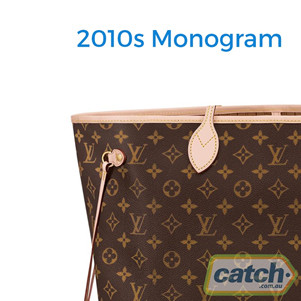
Here are some key points to take note of:
- The monogram patterning should have irregular properties, with the patterning starting asymmetrically.
- When it comes to the LV lettering, the L should sit at the bottom, with the V sitting slightly above and overlapping, followed by a fleur de lis style flower, a circle, flower and LV again. This pattern should repeat.
- Going across, the fleur de lis should be an inverse version, followed by a circle, inverse, circle and so on.
- The bag patterning should be symmetrical - if one corner of the bag starts out with half an inverse fleur de lis, if you follow the pattern all the way (both diagonally and horizontally), it should end with half an inverse fleur de lis - like a mirror image.
- The LV logo on the monogram will very rarely be cut off anywhere - especially with modern Louis Vuitton bags (but can be seen on vintage bags).
- The leather is one solid piece that continues to the front from the back. You will never see a seam in the middle of a bag.
- Fun fact: The popular Louis Vuitton Speedy and Keepall bags are crafted from one continuous panel of leather with no seams on the base, resulting in the monogram pattern on one side of the handbag being upside down from the other side of the bag. This will never occur in bags that are made of two pieces of canvas connected in a seam at the base (like the Louis Vuitton Neverfull bags).
- If the bag is made of Damier Ebene canvas, the logo “Louis Vuitton Paris” spellout logo in a square should be in the same line on one side of the bag as it is on another.
-
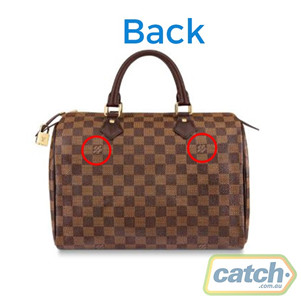
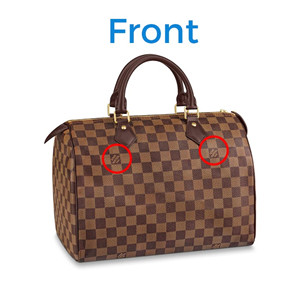
- There shouldn’t be any tilting of the logo, smudging, blurred edges or greenish tints.
TEST YOUR KNOWLEDGE: QUIZ, 4 options - which monogram is correct?




2. Stiching
Louis Vuitton are very meticulous about stitching. So what are some key areas to pay close attention to?
- The stitches should be perfectly straight and and even, with the number of stitches remaining consistent. For instance, on Louis Vuitton Alma, and Speedy bags, there will be five stitches across each of the tabs that secure the handles. The left and right handles should each have 5 stitches running across. Take a second to count the number of stitches on each handle tab of the LV bag you’re analysing.
- Authentic LV bags will always have a yellow-mustard colour stitching, whereas on replica bags, it is often a bright yellow stitching that is used. The stitching on most classic Louis Vuitton bags is white thread made from linen that is later dyed yellow and reinforced with beeswax.
- New Louis Vuitton bags will have precise and durable stitching that will not show any loose threads. The handles of each bag are seamed together with a special glue that bonds the leather. Any sloppy craftsmanship such as extra (visible) glue and loose stitching is an indication that the bag may be fake. Although it goes without saying, loose stitching is not uncommon with vintage used Louis Vuitton bags - keep this in mind when you are purchasing second hand.
3. Lettering
All authentic Louis Vuitton bags will have the words ‘LOUIS VUITTON PARIS’ along with the circle R trademark logo (and sometimes the country it was made in: ‘made in ____’). Although LV is a French brand, by the 70s and 80s, it could not keep up with the demand, and thus had no choice but to outsource its production of bags to other countries. Thus, bags are also manufactured in the USA, Spain, Germany, Italy and Switzerland.
- Wherever you see Louis Vuitton spelled out (this includes on the Damier bags too), check to see that the O is round and not oval shaped. Replicas tend to have an oval shaped O's instead of round ones. Below is lettering from a replica bag.
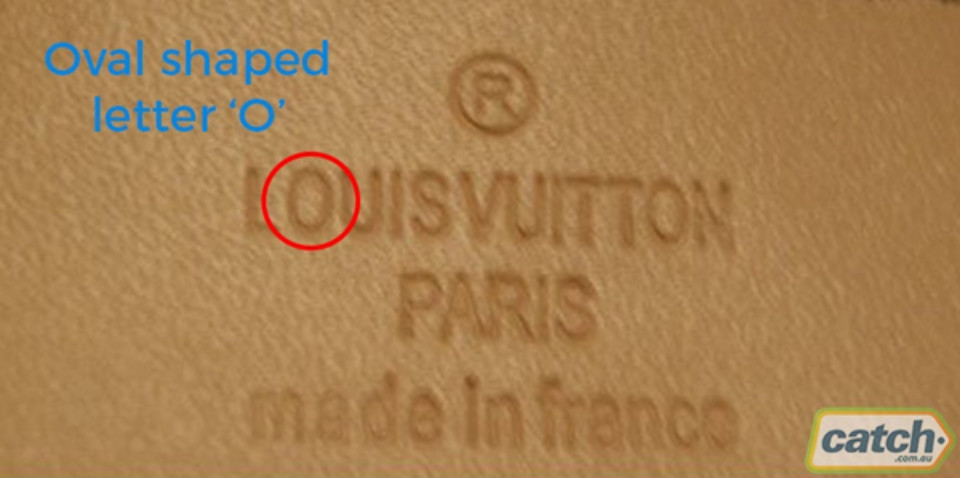
- The letter L immediately before the O should be very closely positioned to the O and should not fully extend on the bottom - in other words, the vertical line should be substantially longer than the horizontal line.
- The name Louis Vuitton is almost always spelled out in all capital letters. In the rare case that it isn’t, a distinctive script is used - Zecraft gives examples of this not-so-easy to replicate font.
4. Certificate of Authenticity
Another indicator that a bag is fake is the authenticity card. Real Louis Vuitton bags do not come with a certificate of authenticity. You may find a cream coloured card with the style name of the bag and a bar code inside, but never a certificate. Many fake bags come with a certificate, in order to lead consumers into believing the bag is real.
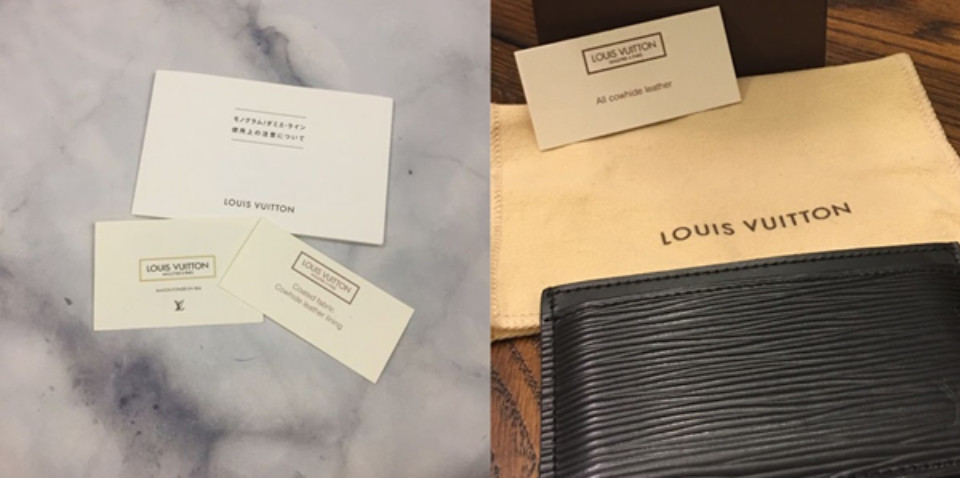
5. Handles
This is a really interesting point.
On all authentic LV bags, the Vachetta leather handles (and any other leather area of the bag) are initially a very pale,beige colour, and quite soft. Louis Vuitton uses a natural-toned cowhide leather that deepens to a rich honey colour with age. The handle should gradually oxidise and darken (from factors such as the oils on your hand and other elements in the environment). Therefore, if you are looking to purchase a vintage second hand/pre-loved LV bag, expect the handles to be darker in colour.
This change in color is called a patina.

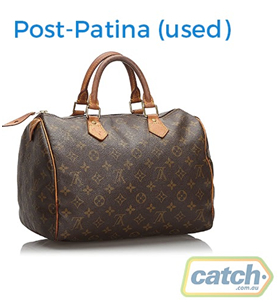
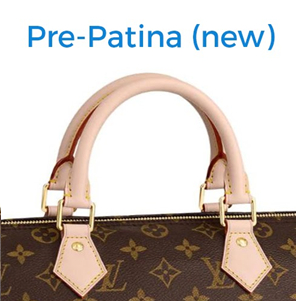
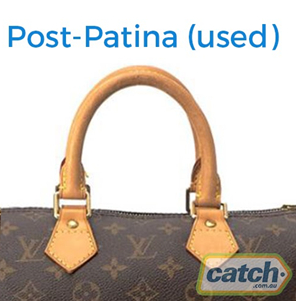
All handles also have a contrasting red trim. This red is initially a very burgundy red, which also darkens over time. On replica bags, the trim is often a bright lipstick red that rarely fades with age.
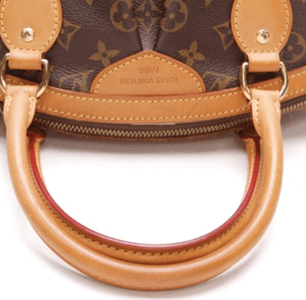
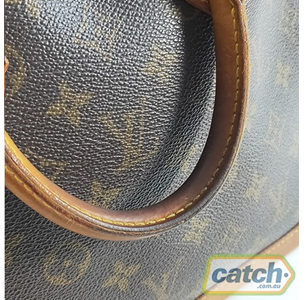
What type of leather do Louis Vuitton use?
6. Hardware
The types of hardware commonly seen on Louis Vuitton bags include zipper tabs, rivets, padlocks, buckles, rings and clasps. Here are some points to take note of:
- All hardware on authentic LV bags is brass-plated and thus has some weight to it. This brass will turn bronze or develop a greenish hue around the rivets, as real brass oxidises with air over time. On counterfeit versions, the hardware is just a metal base or plastic coloured in gold. The gold is often a bright yellow gold, quite poor quality and lightweight.
- The connecting rings on authentic Louis Vuitton bags will be D-shaped rings, while fake bags tend to use rounded ring hooks. If you come across square pieces on an authentic bag, their edges should be very smooth and not sharp at all.
- Every piece of circular hardware on an authentic bag should have a Louis Vuitton engraving that is precise and well-executed. The Louis Vuitton spell-out on round rivets should also be perfectly circled.
- Finally, Louis Vuitton’s hardware is usually in brass, golden brass or silvery metal (although matte finishings do exist).
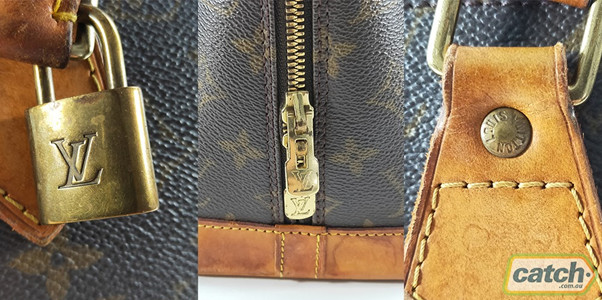
7. Lining
Although different bag linings may be used depending on the collection, the monogram bags are usually lined in brown cotton textile, while the Damier Ebene bags are lined in red microfibre. Epi Leather and Mahina handbags are lined with a suede-like microfibre, often in a colour that matches the exterior but something in a contrasting hue. If the bag has a brown or tan suede lining, it is not authentic.
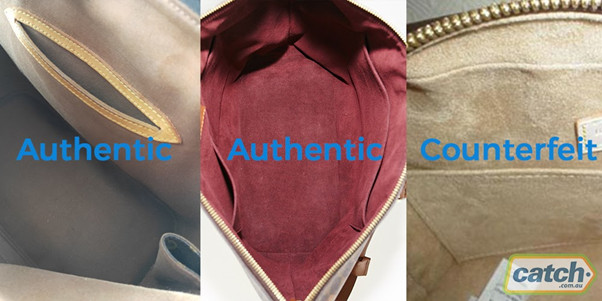
8. Stamping
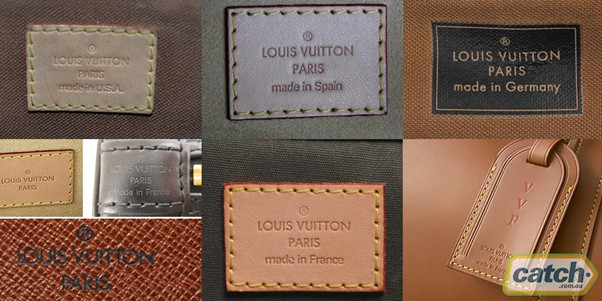
Some LV bags will be stamped, as seen in the images below.
Here are some of the features to pay attention to. Remember, it’s all in the details...
- The tail on the L is very short.
- The O's are very round and look bigger than the L.
- The T's are almost touching each other or are so close that it looks like it.
- Lettering should be thin to somewhat thin, clear and very crisp.
- Study the general font used and how it is aligned.
- Text is perfectly centered on a square of leather
- * There are rare exceptions to the above rules.
If you don’t see these characteristics on the stamping, be skeptical about the authenticity of the bag.
But the stamp alone should not be used as the sole indicator, as many counterfeits have almost mastered this area!
9. Date Code/Serial number

There is no such thing as a Louis Vuitton serial number. All LV handbags have what’s known as a “date code” stamped somewhere on the bag.
This is one to be wary of, as the date stamping on fake LV bags are becoming harder and harder to tell apart from the real ones.
- The leather tab displaying the date stamp will always be located inside the bag or debossed on the side near a seam inside the bag. E.g. With a LV speedy, it will be behind the inner pocket on the backside of the handle.
- The indentation of the stamping should always be even, with the letters and numbers evenly spaced.
- With replicas, sometimes the indentation of some letter is deeper or not as deep/shallower than others, with the letter/number spacing being a lot closer
Here is a full breakdown of the date codes:
Pre-19080s bags: LV did not have an organised dating system. Most of the bags before this time, simply did not have a date stamp code. The date stamping code was introduced from the 1980s onwards, using a combination of letters and numbers
Early-mid 1980s: Three or four digit system, with no letters. The first two numbers representing the year and the last number(s) representing the month.
E.g. A bag with the code 841 means: 84 = year of production (1984), 1= month of production (January)
Mid-late 1980s: Three or four digits followed by two letters. The first two numbers representing the year and the last number(s) representing the month. The letters representing the country the bag was manufactured in.
- e.g . FC884 means: The bag was manufactured in the USA in April of 1988.
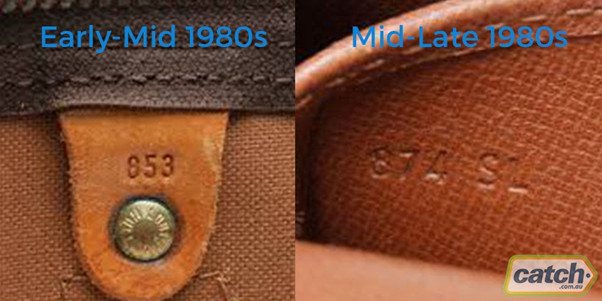
1990-2006: Two letters followed by 4 digits. The first two numbers representing the factory location. The first and third number represent the month. The second and fourth number represent the year.
2007 onwards: two letters followed by four digits. The first two letters representing the factory location. The first and third numbers represent the week of the year. The second and fourth numbers represent the year.
E.g. SD1132 means the bag was manufactured in France or the US in the 11th week (March) of 2012.

Country Code Letters:
France:
A0, A1, A2, AA, AAS (Special Order), AH, AN, AR, AS, BA, BJ, BU, DU, DR, DT, CO, CT, CX, ET, FL (Also USA), LW (also Spain), MB, MI, NO, RA, RI, SD (Also USA), SA (also Italy), SF, SL, SN, SP, SR, TJ, TH, TN, TR, TS, VI, VX
Italy:
BC, BO, CE, FO, MA, OB, PL, RC, RE, SA (also France), TD
Spain:
CA, LO, LB, LM, LW, GI, UB
USA:
FC, FH, LA, OS, SD (Also France), FL (Also France), TX
Germany:
LP, OL
Switzerland:
DI, FA
“TAKE THE QUIZ HERE” (interactive quiz on breaking down a date code).
1. 8210
2. LM0095
3. CT1124
10. The French Luggage Company (TFLC)
Before the 1970s, Louis Vuitton only made its bags in France, but due to the dramatic increase in demand from the US, the fashion house enlisted the help of US luggage specialists, TFLC. Thus from 1976, TFLC worked with Louis Vuitton for almost 30 years, manufacturing bags under a special license. The bags were all made and sold in the US in high-end department stores.
Here are some differences with Louis Vuitton bags by TFLC
- No date codes
- Different look to the embossing
- Label is made of Tyvek and easy to remove
- An explanation that it was made under a special license in the US (“Manufactured by the french co, USA, under special license”)
- Hardware is usually plated nickel and features no logos or debossing
- Zipper pulls are by Talon or Eclair and don’t feature the LV logo
- Coated leather instead of Vachetta leather
- Leather oval patches are stitched onto all bags
- Speedys by TFLC have a break in the canvas along the bottom and the monogram/LVs will be the right way up on both sides of the bag.
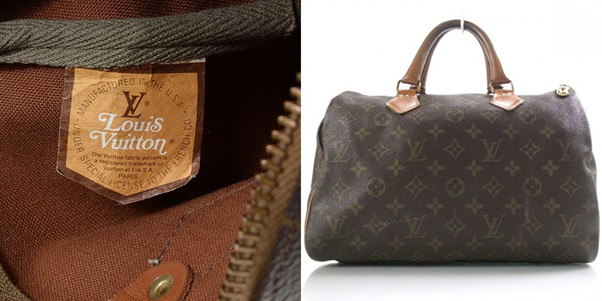
11. Zippers
Prior to the 1980s to mid 1980s, many models of Louis Vuitton bags used zippers made by other companies - ECLAIR, TALON, and Coats & Clarks.
- ECLAIR
- Eclair branded zippers were used on a wide range of Louis Vuitton bags from Sppedys to Mini Speedys, Papillon, Keepall, Weekend and more throughout the early 80s, as well as Louis Vuitton original zippers.
- TALON
- TFLC uses TALON manufactured zippers, and are not used on any model manufactured outside of the US.
- Coats & Clarks
Although not as common, some bags will have the C&C logo etched/debossed onto each zipper tab
Additional Points:
- Since 1991, Louis Vuitton has been using its golden brass hardware with its iconic LV logo (embossed) or “LOUIS VUITTON” spell-out (debossed). The back of these zippers will always be blank.
- There are matte and shiny zippers, depending on the bag
- It's important to keep in mind that the gold brass can tarnish, wear and chip overtime. This doesn't necessarily mean the bag is fake or the brass isn’t real.
Louis Vuitton Speedy bags with an upside down monogram on one side are not authentic
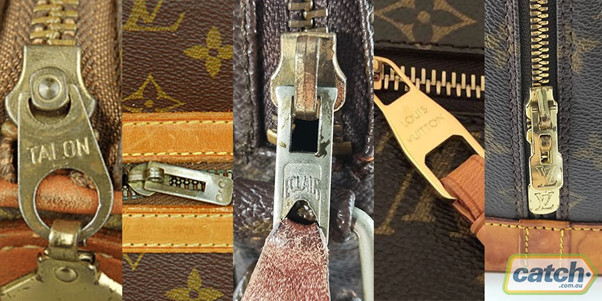
12. Dust Bags
All authentic LV bags come with a soft dust bag. This bag is done in a soft tan color and features the Louis Vuitton logo in the center. The dust bag can be done in a drawstring or envelope style.
Dust covers are extremely simple, made of 100 percent cotton with neatly finished seams. Earlier versions are light tan with an LV logo; more recently, the name has been spelled out on a pale saffron background. No other text will appear.
The dust bag should only say LOUIS VUITTON or have a monogram, no additional information. Often, fake manufacturers put too much information and thus compromise themselves.
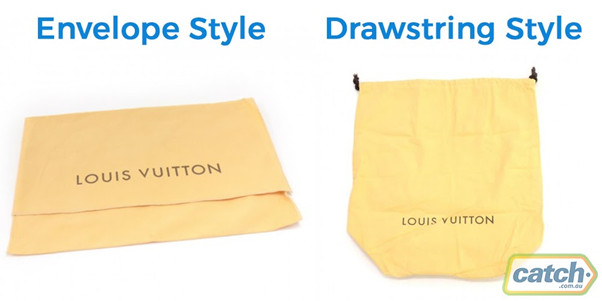
13. Use common sense
Louis Vuitton bags never go on sale, nor do they have sample sales or sell second hand/faulty stock. Don’t believe websites that say they do. LV is a luxury bag company. If a price seems too good to be true, it’s probably best to stay away.
Louis Vuitton will not wrap plastic or paper around handles or hardware in order to protect them. The company will not put hang tags on bags and it will never, ever misspell it’s own name (but you knew that).
So there you have it! With all this information, you should be able to comfortably determine whether a Louis Vuitton bag is the real deal or not. Be sure to save this guide in your bookmarks so you always know what to pull up when it’s time to play detective. You’ll be glad to know that the task of authenticating has already been completed for the range of pre-loved Louis Vuitton bags sold here at Catch. Check them out today and add a piece of French luxury to your cart today!